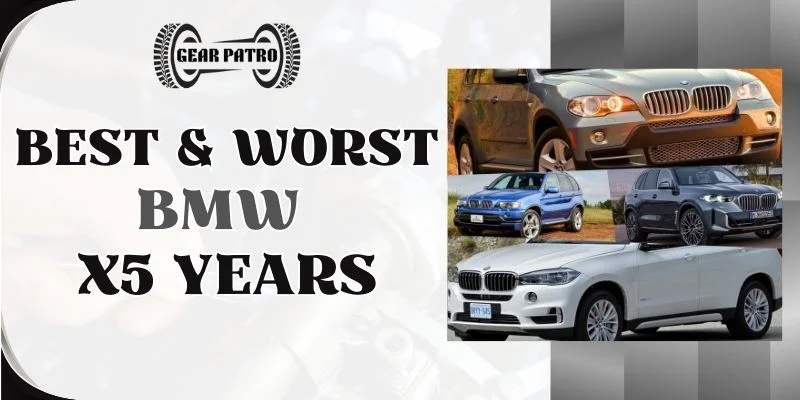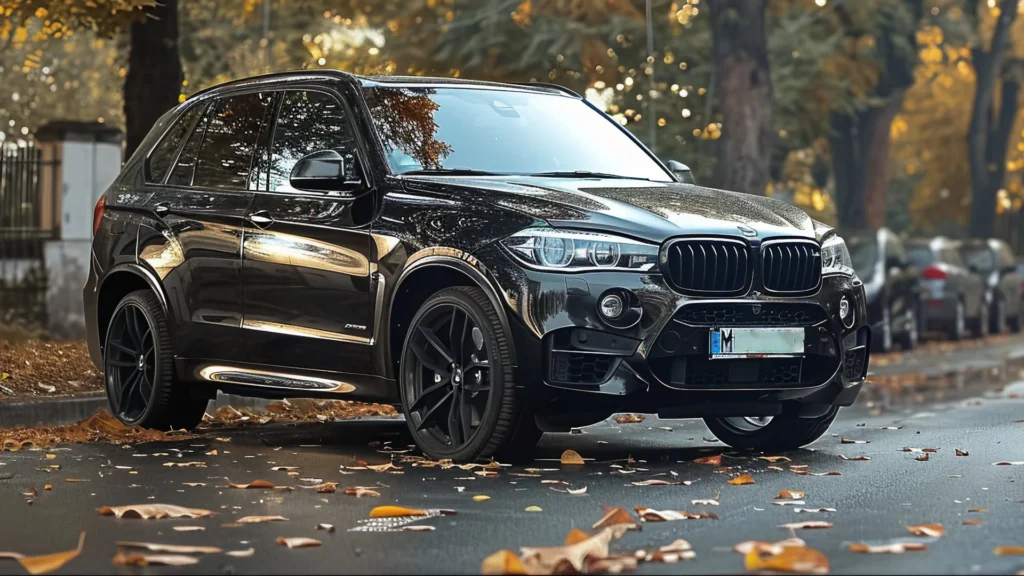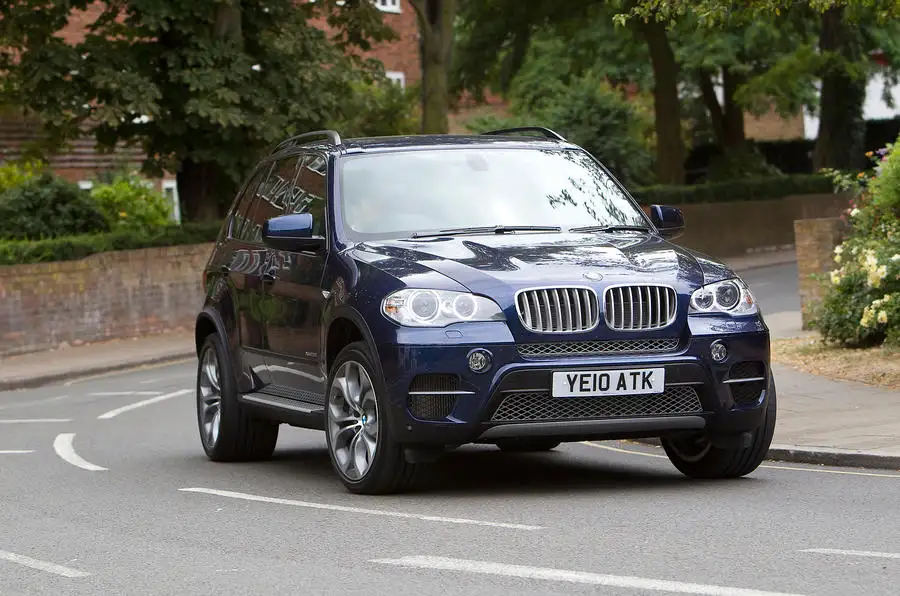With this guide, you’ll be able to pick the best BMW X5 years and avoid the worst BMW X5 years. Listed below is a summary of which options you should choose.
This ultimate guide summarizes all generations of the BMW X5, highlighting which years are best for buying and which years are worst to avoid buying.

The following is a comprehensive analysis of the most reliable BMW X5 years based on data, reviews, and first-hand experiences drawn from authoritative sources such as NHTSA, J.D. Power, and Kelley Blue Book.
Discover the best and worst years for the BMW X5 and learn how its resale value fluctuates over time as you journey through the X5’s storied history.
It’s time to get started.
BMW X5 Generations
With the introduction of the BMW X5, BMW entered the luxury SUV segment for the first time. Featuring a blend of performance, luxury, and versatility, the first generation (E53) marked a milestone for the Bavarian automaker.
Designed as a Sports Activity Vehicle (SAV) rather than an SUV, the X5 offers BMW’s trademark driving dynamics along with a car-like platform that makes it stand out among other vehicles.
In the table below, you will find an overview of all BMW X5 generations, from 2000 to the present:
| Generation | Years |
| 1st generation (E53) | 2000-2006 |
| 2nd generation (E70) | 2007-2013 |
| 3rd generation (F15/F85) | 2014-2018 |
| 4th generation (G05/G18) | 2019-Present |
It is crucial to understand generational changes since they often include technological advancements, aesthetic improvements, and performance tweaks that could determine a buyer’s decision.
BMW X5 Best, Neutral, and Worst Years
We heavily consider various factors when ranking and categorizing the best and worst years for the BMW X5, including but not limited to:
Using our in-house algorithm, we’ve compiled all BMW X5 ratings from the sources mentioned, presenting a comprehensive overview.
In the next section, we will categorize all BMW X5 model years according to their combined metrics, identifying the best, neutral, and worst years in the segment.
| Generation | Best Years | Neutral Years | Worst Years |
| 1st generation (E53) | 2005 2006 | 2002 2003 | 2000 2001 2004 |
| 2nd generation (E70) | 2013 | 2012 | 2007 2008 2009 2010 2011 |
| 3rd generation (F15/F85) | 2018 | N/A | 2014 2015 2016 2017 |
| 4th generation (G05/G18) | 2019 2022 2023 2024 | N/A | 2020 2021 |
As far as “Neutral Years” are concerned, we mean those model years that were neither overwhelmingly positive nor overwhelmingly negative. Average owners will find them to be balanced in terms of performance and experience.
You must understand that some factors, such as the number of recalls filed by the NHTSA, can cast a negative light on a car. The number of complaints and recalls associated with a vehicle generally indicates a decreased level of reliability.
Let’s take a look at the best, neutral, and worst year specifications of the BMW X5.
Best & Worst Years for BMW X5 1st Generation (2000-2006)
The BMW X5, introduced in 2000, made BMW the first automaker to enter the SUV segment (SAV), combining the brand’s sporty DNA with a larger vehicle’s practicality.
A BMW X5 from this generation is best purchased in the later years – 2005 and 2006. BMW X5 models from 2002, 2003, and 2004 are the years to avoid since they aren’t as reliable as the earlier models.

Since the first-generation BMW X5 has received a huge number of recalls from the NHTSA, it is very important to do thorough research and determine the vehicle’s VIN number.
The Best Years: 2005, 2006
The BMW X5 enjoyed significant improvements over its predecessors in 2005 and 2006, despite being at the tail end of the generation.
A range of refined engines were available for these models, including a 3.0i inline-six, 4.4i V8, and the top-of-the-line 4.8is V8 that returned 12 miles per gallon in the city and 26 mpg on the highway.
In addition to offering competitive performance and efficiency, the engines provided a driving experience that lived up to BMW’s reputation for sportiness.
As far as technology is concerned, these models feature advanced safety systems such as Dynamic Stability Control and optional adaptive headlights, which make them a much safer option than earlier models.
It has even undergone a minor facelift in 2006, giving it a more appealing appearance.
While the 2006 X5 featured advancements, there were recalls concerning the rear shock absorbers and Occupant Detection System (ODS). There is a possibility that the rubber mount at the bottom of these absorbers is not adhered to its housing properly and that ODS sensors may be defective.
The Neutral Years: 2002, 2003
Due to their equally balanced mix of pros and cons, the 2002 and 2003 BMW X5 models stand out as neutral years.
A more dynamic driving experience was offered with these models in terms of trims and powertrains. For instance, the 2002 model made the X5 a true performance SUV by introducing a 4.6i V8 engine.
A number of technological advances also took place during these years, including the birth of BMW’s iDrive system. The complexity of this system, however, often led to criticism.
In 2003, the 2003 model remained unrecalled, but owners reported that an oil separator issue could cause fluid leaks and consequent smoke.
The Worst Years: 2000, 2001, 2004
There is no doubt that you should stay away from BMW X5 models made in 2000, 2001, and 2004.
It was discovered that the window regulators of the 2000 BMW X5 model were faulty and that the windshield wipers were malfunctioning.
In the 4.4l engine variants, the transmission gear position indicator switch was recalled for the possibility of disrupting electrical contacts and activating emergency transmission functions.
It was also recalled for possible brake performance compromises due to the pivot shaft of the brake pedal arm.
The brake line chaffing recall in 2001 addressed increased stopping distances and fluid loss caused by brake line chaffing.
While many enhancements were carried over from the previous year, the 2004 BMW X5 experienced two major recalls.
The first involved a fire hazard due to overheating of the battery cable insulated bulkhead connector, and the second concerned brake vacuum pump performance, which might reduce power-assist braking.
The 2004 model also suffered from jerky transmissions.
Recalls and complaints regarding BMW X5 from NHTSA in 2000, 2001, 2002, 2003, 2004, 2006 are available.
Best & Worst Years for BMW X5 2nd Generation (2007-2013)
Following the success of its predecessor, the second-generation BMW X5 was introduced for the 2007 model year in 2006. As far as the BMW X5 is concerned, 2013 is the year when it performs best in this generation, as well as 2007, 2008, 2009, 2010, and 2011 which are the BMW X5 years to avoid.

The BMW X5 2nd generation has a considerable number of NHTSA recalls and low ratings, so it is important to proceed with caution. Prior to purchasing, do thorough research and make sure it is a good deal.
The Best Years: 2013
BMW X5 has had its best year in this generation in 2013 because there have been relatively few recalls and complaints from owners. As a result of the lessons learned in previous model years, this year’s model benefits significantly.
There was now a variety of powertrain choices, from the base 3.0L inline-six engine to the more powerful 4.4L V8, and even a diesel option for drivers seeking fuel efficiency and torque.
The fuel economy of this generation’s models is 12 mpg in urban areas and 25 mpg on the freeway, according to Consumer Reports.
Also featured was BMW’s new iDrive system, which had undergone a number of revisions as a result of earlier criticisms, which led to a more intuitive driving experience.
There have been some safety features added to the X5’s feature list, such as lane departure warnings and a head-up display.
The 2013 BMW X5 is the only model in the second-generation X5 lineage to achieve 80 J.D. Power points.
A Kelley Blue Book rating of 4.1 assigned to this generation makes it the lowest among all generations. There were also negative reviews on other platforms, including Edmunds, Cars.com, and VehicleHistory.
The Neutral Years: 2012
The BMW X5 went through a transitional year in 2012.
Despite offering many of the technical and luxury features the brand is known for, the 2014 model sat smack in the middle of the challenges faced with the second-generation models and the refinements made in the 2013 model.
There were no changes to the powertrain options, but they were enhanced in fuel efficiency and some things were tweaked to make them more efficient.
Comparatively to the early years of this generation, there were fewer recalls and complaints this year.
Despite these challenges, the vehicle faced some challenges, such as a recall concerning the power-assist braking system, which could lead to a crash if malfunctioned.
The Worst Years: 2007, 2008, 2009, 2010, 2011
A variety of issues plagued the 2007 BMW X5s, resulting in numerous recalls and complaints. Thus, these years should be avoided like the plague.
This page contains a collection of owner complaints and recalls for BMW X5 models from these years. At the bottom of this page are links to all the NHTSA BMW X5 recalls for the years 2007-2011, as well as the owner complaints.
It was found that incorrect materials were used in the rear brake disc of the 2007 BMW X5, which may have resulted in reduced braking performance.
It was reported that the front driveshaft universal joint of the X5 was prone to breaking in 2008, affecting the vehicle’s handling.
There is a recall for 2008 BMW X5 SAVs equipped with 6-cylinder engines regarding fuel pump malfunctions that can cause engines to stall.
There were also recalls for the 2009 BMW X5, including fuel filter heater problems that could cause short circuits, causing a fire risk, and engine belt idler pulley bolts that could loosen and break, resulting in power steering assistance being lost unexpectedly and increasing accident risks.
BMW X5 models from 2010 and 2011 continued to suffer recalls, despite some improvements.
Several BMW X5 models have been recalled, most recently the 2010 model for an inaccurate fuel gauge, while the 2011 model is being recalled due to a potential power steering fluid leak.
The NHTSA has recalled and complained about the BMW X5 in 2007, 2008, 2009, 2010, and 2011.
Best & Worst Years for BMW X5 3rd Generation (2014-2018)
As part of the 2014 model year, BMW introduced the third-generation X5, marking a significant evolution in design, technology, and performance.

This generation’s best year is 2018, followed by 2014, 2015, 2016, and 2017. 2014, 2015, 2016, and 2017 are years to avoid in this generation for BMW X5.
The Best Years: 2018
Is there a most reliable BMW X5 model year? This is why I like the 2018 BMW X5 model:
The BMW X5 had nearly reached perfection by 2018. BMW’s technological advancements helped make this SUV a more mature vehicle.
For 2018, the BMW X5 was available with optional laser headlights, a more advanced iDrive system with gesture control, as well as an off-road package designed for off-road driving.
A range of powertrain variations ensured there was an X5 for every need, including the turbocharged 3.0L inline-six, the twin-turbo 4.4L V8, and plug-in hybrid versions.
According to Consumer Reports, the third generation X5 model achieves an average fuel consumption of 14 mpg in urban and 28 mpg on the highway.
According to J.D Power and Cars.com, the 2018 BMW X5 scored 81 points.
In addition to safety features like forward collision warning, blind-spot detection, and lane departure warning, BMW introduced its Active Driving Assistant.
The Worst Years: 2014, 2015, 2016, 2017
The BMW X5 isn’t a good choice in the early years of this generation – 2014, 2015, 2016, and 2017.
The only BMW X5 with relatively serious problems is the 2014 model, while the 2015, 2016, and 2017 models still have good ratings, such as 81 points from J.D. Power.
An issue with the VANOS system found in the 2014 BMW X5 model year led to a recall. The VANOS system adjusts the position of the intake and exhaust camshafts, causing the intake and exhaust camshafts to be separate. An engine that performs poorly could cause an accident and reduce the engine’s performance.
With airbag recalls related to the 2015 BMW X5, the vehicle continued to experience problems. If an airbag malfunctions, occupants are significantly more likely to be injured during a collision.
Best & Worst Lexus RX 350 Years | Years To Avoid
Best & Worst BMW X3 Years | Years To Avoid
There was also a potential fire hazard associated with the fuel pump collar in some models.
Despite progress in improving the X5’s reputation, there were setbacks with the 2016 model. Several child seat anchors were deemed not to be properly welded this year, leaving the child less protected in case of an accident.
During 2017, BMW was able to solve a majority of these challenges. An important recall, however, dealt with a problem with the transmission that could cause the vehicle to roll away after parking.
While improvements were evident, reliability issues still loomed, along with concerns over the rear suspension.
A recall was issued in 2018 by BMW for X5 xDrive35d SAV models with an Exhaust Gas Recirculation (EGR) module with an integrated cooler in 2014, 2015, and 2016. There was a concern that coolant might mix with diesel engine soot and melt the intake manifold, increasing fire safety risks.
Another recall was issued by BMW in 2021 regarding high-pressure fuel pumps which may fail and lead to engine stalls for certain 2014, 2015, 2016, 2017, and 2018 X5 xDrive35d models.
The NHTSA issued recalls and complaints for the BMW X5 in 2014, 2015, 2016, and 2017.
Best & Worst Years for BMW X5 4th Generation (2019-Present)
A new era of luxury, technological advancement, and performance is dawning on BMW’s midsize SUV segment with the fourth-generation BMW X5.

As for the BMW X5, the best years in this generation are 2019, 2022, 2023, and 2024, while the least desirable years are 2020 and 2021.
The Best Years: 2019, 2022, 2023, 2024
Four of the best years for the BMW X5 in the fourth generation are unquestionably 2019, 2022, 2023, and 2024.
It will be evident in the 2019 model year, as well as the 2022, 2023, and likely the 2024 models that BMW is focused on improving and refining the X5.
In J.D Power ratings, the 2019 BMW X5 averages 80, and the 2018 version averages 4.8 on VehicleHistory and 4.7 on Cars.com.
The BMW car manufacturer had introduced a great deal of technology by the year 2022. These models were equipped with the innovative iDrive 7.0 system, which combined intuitive interfaces with voice control. The integration of Apple CarPlay and Android Auto has become standard, thus ensuring seamless use with smartphones.
The safety of everyone was paramount as always. With BMW’s 2022 model, drivers can take advantage of semi-autonomous driving abilities and improved lane-keeping assistance thanks to the Driving Assistant Professional package.
With its impressive electric range and reduced emissions without compromising on performance, the xDrive45e plug-in hybrid variant gained attention in these years for its efficiency and performance.
The Worst Years: 2020, 2021
It is recommended to avoid the BMW X5’s beginning years, namely 2020 and 2021, as they are the worst for the fourth generation.
One of the most common concerns reported in 2020 was related to the brake system of the vehicle. When the brake assist malfunctioned under certain conditions, it could potentially increase stopping distance and accident risk. The NHTSA documented issues involving brake assist malfunctions.
In spite of enhancements such as a 48-volt mild-hybrid system on the sDrive40i and xDrive40i, there were issues with the 2021 model.
A recall was issued regarding the possibility of fuel leaks in the engine compartment, posing an increased fire risk. Aside from this, some models’ rearview cameras displayed images incorrectly, posing a risk, especially during reverse maneuvers.
The NHTSA has issued recalls and complaints regarding the BMW X5 for 2020 and 2021.
Conclusion
Upon concluding this guide, we can clearly state that 2006, 2013, 2018, and newer models are among the best BMW X5s.
What is your best and worst experience with the BMW X5? Based on your experience, which years of the BMW X5 are most reliable?
Feel free to share your thoughts and experiences in the comments!
